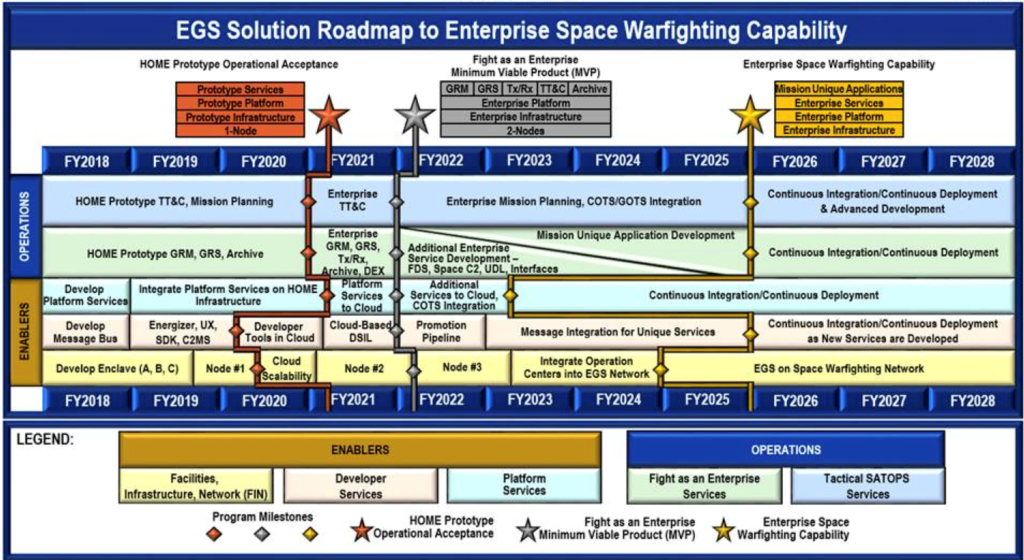Space and Missile Systems Center (SMC) is wrapping up the prototype phase of its ambitious effort to create a common tool kit for routine command and control (C2) of all DoD’s satellites. SMC now aims to have an acquisition strategy ready in time for the fiscal 2023 budget chop, officials say.
“We are putting together that formal acquisition strategy,” Joshua Sullivan, SMC’s program manager for the Enterprise Ground Services (EGS) said in an interview yesterday. “I expect that we will start coordinating through the Space Force on that in the next fiscal year, so in FY22.”
The goal is not to come up with one end-to-end C2 ground system, or even one regulation terminal, for everything from the GPS satellites to the Space Based Infrared System (SBIRS) missile warning constellation. Instead, EGS is attempting to create a core set common ground system capabilities that everyone will use as a baseline, but that also allows operators of each mission-specific satellite to plug in Lego-like pieces of unique software/hardware required for those different missions, explained Lt. Col. Kellie Brownlee, who leads SMC’s Future Ground Integration Branch.
The former Air Force Space Command started the EGS effort in 2014, pushed by Congress in the 2014 National Defense Authorization Act (NDAA) and a 2013 study by the Government Accountability Office.
“EGS was formed out of a mission need for common tactical C2 to address the constraints, challenges and vulnerabilities derived from traditional stove-piped satellite ground systems growing increasingly inefficient and sub-optimal,” explained a background paper provided to Breaking D by SMC. The increasing need for resiliency in DoD’s satellite ground system infrastructure and improved network cybersecurity in the face of growing threats from China and Russia also are driving factors — issues reiterated by Congress in the 2020 NDAA.
With the Air and Space Forces focused on “agile” development and digitization, Sullivan explained, EGS also is focusing on the need to move away from vendor-locked subsystems to open software standards that will allow DoD to more easily upgrade C2 functions in the future.
Sullivan’s team doesn’t have an easy task. Currently, each specific DoD satellite network — from missile warning to top-secret communications — has its own, specialized C2 system, including software, terminals, antennas, receivers and even buildings. For example, the operators of the Global Positioning System (GPS) have their own control center, servers, computers and unique software programs.
Standardizing C2 Operations
Thus, the first step for EGS is sorting out an “architecture” that defines which of those day-to-day satellite functions (known as tactical C2) and the accompanying software/hardware/infrastructure can be standardized. “We are working through completing the prototyping phase of our enterprise architecture work,” Sullivan said. The program office also has just finalized a draft “roadmap” for how it intends to get from here to there.

EGS is trying to come up with a kind of “catalog of common services” for operators, he said, to include “facility services, infrastructure services, network services, platform services” and “software services and applications.” Those services range from providing software programs for routine satellite operations, to standardized hardware such as antenna connections, to cloud-based data storage, to joint data centers with shared servers, he explained.
Specifically, according to SMC’s backgrounder, these services would include: “Command & Telemetry, Mission Planning, Ground Resource Scheduling (GRS), Ground Resource Management (GRM), Data Analytics (DEX), Transmit/Receive (Tx/Rx), Archive, User Experience (UX), EGS Software Development Kit (ESDK), EGS Application Template (EAT), Reference Implementation (RI), etc.”
“It is complex,” Sullivan said. He noted that a key complicating factor is the need to be “able to adapt to different mission areas that are at different stages of the acquisition lifecycle.”
For example, DoD is in the process of transitioning from SBIRS to the Next-Generation Overhead Persistent Infrared (Next-Gen OPIR) missile warning constellation. SMC issued a $4.9 billion production contract to Lockheed Martin in January for Next-Gen OPIR, with the first satellite expected to reach orbit in 2025. SMC also is working to develop a ground system that focuses on processing the OPIR data from both SBIRS and Next-Gen OPIR: the Future Operationally Resilient Ground Evolution (FORGE).
“So, we don’t have a one ‘Big Bang’ system that we’re providing,” Sullivan said. “By breaking things into services, it gives us the agility to work with the FORGE team where they are in their acquisition cycle and to work with a SATCOM team where they are in their acquisition cycle to evolve the legacy systems into the enterprise baseline.”
FORGE, in turn, is being developed by SMC and is utilizing multiple prime contractors: one of those prime contractors, Raytheon, is developing the Mission Data Processing open architecture. The FORGE team is also partnering with EGS to develop C2 Mission Unique Software (MUS) that will utilize the EGS open architecture, explained Brownlee.
“I’m partnering with Josh so we can remove ourselves as a stovepipe system, and helping him create that C2 functionality” for SBIRS and Next-Gen OPIR satellites. She said this partnership brings expertise in both missile warning and C2 to enable integration of FORGE into EGS.
Connecting Legacy Systems
Sullivan said the EGS catalog “initially is focused on some of the key things to bring the enterprise together” — in other words, figuring out how to translate between current legacy ground system computers.
For example, he said, EGS is developing a “common message standard,” so that “the SATCOM team can pass message traffic to the missile warning team and the position, navigation and timing team, and all of that traffic can flow up to a strategic command and control decision-maker, and they can have a common operating picture.” Common message standards will allow machine-to-machine communication between, say, GPS C2 computers and SBIRS computers, Sullivan explained, rather than requiring a “sneaker-net” of message-running junior officers.
As a thought experiment, Sullivan said, think about a situation where a piece of space debris has been spotted by the Space Force’s space surveillance network, and a commander needs to to let operators know that their satellites need to move out of the way. “Right now, there is no machine-to-machine interface, you have to do phone calls or emails to each of the different missions to be able to do that coordination,” he said. What EGS would provide via the common message standard is, in effect, the ability to push one button to send out a computerized message to all the tactical operators at the same time.
Once the EGS architecture has been fully fleshed out, then SMC has to determine how to develop, buy or partner with commercial industry to obtain EGS components best designed to accomplish those tasks. And, that all has to be done and dusted in time for Space Force’s individual satellite programs to meet the EGS “mandatory use” deadline of 2028.
HOME Prototype
The teams led by Sullivan and Brownlee also have been working together to prototype elements of the EGS architecture using the two SBIRS sensors currently operating as hosted payloads on satellites in Highly Elliptical Orbit (HEO, which crosses over the poles.) Once that prototype is complete, the focus will then be on the full constellation of six satellites in Geosynchronous Orbit (GEO). All six of the GEO sats are expected to be on orbit by 2022.
The “HEO Operations Migration to EGS (HOME)” project “tested and operationally accepted ground system software that provides automated ‘lights-out’ command and control and State-of-Health monitoring for SBIRS HEOs 1 & 2 payloads,” SMC’s backgrounder explained.
These prototype systems, known as HOME Increment 1, were accepted by Space Force in September, and now can be utilized for C2 of the two SBIRS HEO sensors.
“We’ve obtained an acceptance of the initial capability that’s helped to prove out the open architecture. EGS concept and the FORGE goal of working with third-party vendors,” Sullivan said. ” Using the agile frameworks that we have going on, we’re continuing to iterate on that and add additional capabilities for the operators.”
In particular, HOME Increment 1 has improved cybersecurity of the legacy HEO sats. It uses “Manticore, a Defensive Cyberspace Operations for Space (DCO-S) capability that ensures ‘baked-in’ cybersecurity,” the SMC backgrounder said.









































